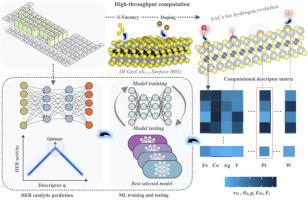Few-shot learning for screening 2D Ga2CoS4−x supported single-atom catalysts for hydrogen production
IF 13.1
1区 化学
Q1 Energy
引用次数: 0
Abstract
Hydrogen generation and related energy applications heavily rely on the hydrogen evolution reaction (HER), which faces challenges of slow kinetics and high overpotential. Efficient electrocatalysts, particularly single-atom catalysts (SACs) on two-dimensional (2D) materials, are essential. This study presents a few-shot machine learning (ML) assisted high-throughput screening of 2D septuple-atomic-layer Ga2CoS4−x supported SACs to predict HER catalytic activity. Initially, density functional theory (DFT) calculations showed that 2D Ga2CoS4 is inactive for HER. However, defective Ga2CoS4−x (x = 0–0.25) monolayers exhibit excellent HER activity due to surface sulfur vacancies (SVs), with predicted overpotentials (0–60 mV) comparable to or lower than commercial Pt/C, which typically exhibits an overpotential of around 50 mV in the acidic electrolyte, when the concentration of surface SV is lower than 8.3%. SVs generate spin-polarized states near the Fermi level, making them effective HER sites. We demonstrate ML-accelerated HER overpotential predictions for all transition metal SACs on 2D Ga2CoS4−x. Using DFT data from 18 SACs, an ML model with high prediction accuracy and reduced computation time was developed. An intrinsic descriptor linking SAC atomic properties to HER overpotential was identified. This study thus provides a framework for screening SACs on 2D materials, enhancing catalyst design.

筛选二维 Ga2CoS4-x 支持的单原子制氢催化剂的少量学习方法
制氢及相关能源应用在很大程度上依赖于氢进化反应(HER),而氢进化反应面临着动力学速度慢和过电位高的挑战。高效的电催化剂,尤其是二维(2D)材料上的单原子催化剂(SAC)至关重要。本研究通过机器学习(ML)辅助高通量筛选二维七原子层 Ga2CoS4-x 支持的单原子催化剂,预测 HER 催化活性。最初,密度泛函理论(DFT)计算表明,二维 Ga2CoS4 对 HER 没有活性。然而,有缺陷的 Ga2CoS4-x(x = 0-0.25)单层由于表面硫空位(SV)而表现出卓越的 HER 活性,其预测过电位(0-60 mV)与商用 Pt/C 相当或更低,当表面 SV 的浓度低于 8.3% 时,商用 Pt/C 在酸性电解质中通常表现出约 50 mV 的过电位。SV 在费米级附近产生自旋极化态,使其成为有效的 HER 位点。我们展示了二维 Ga2CoS4-x 上所有过渡金属 SAC 的 ML 加速 HER 过电势预测。利用 18 种 SAC 的 DFT 数据,我们开发出了一种预测精度高、计算时间短的 ML 模型。确定了将 SAC 原子特性与 HER 过电势联系起来的内在描述因子。因此,这项研究为筛选二维材料上的 SAC 提供了一个框架,从而提高了催化剂的设计水平。
本文章由计算机程序翻译,如有差异,请以英文原文为准。
求助全文
约1分钟内获得全文
求助全文
来源期刊

Journal of Energy Chemistry
CHEMISTRY, APPLIED-CHEMISTRY, PHYSICAL
CiteScore
19.10
自引率
8.40%
发文量
3631
审稿时长
15 days
期刊介绍:
The Journal of Energy Chemistry, the official publication of Science Press and the Dalian Institute of Chemical Physics, Chinese Academy of Sciences, serves as a platform for reporting creative research and innovative applications in energy chemistry. It mainly reports on creative researches and innovative applications of chemical conversions of fossil energy, carbon dioxide, electrochemical energy and hydrogen energy, as well as the conversions of biomass and solar energy related with chemical issues to promote academic exchanges in the field of energy chemistry and to accelerate the exploration, research and development of energy science and technologies.
This journal focuses on original research papers covering various topics within energy chemistry worldwide, including:
Optimized utilization of fossil energy
Hydrogen energy
Conversion and storage of electrochemical energy
Capture, storage, and chemical conversion of carbon dioxide
Materials and nanotechnologies for energy conversion and storage
Chemistry in biomass conversion
Chemistry in the utilization of solar energy
 求助内容:
求助内容: 应助结果提醒方式:
应助结果提醒方式:


